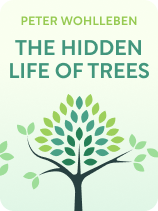

This article is an excerpt from the Shortform book guide to "The Hidden Life of Trees" by Peter Wohlleben. Shortform has the world's best summaries and analyses of books you should be reading.
Like this article? Sign up for a free trial here.
Are you looking for quotes from The Hidden Life of Trees by Peter Wohlleben? What can this book teach you about the importance of protecting forests?
In The Hidden Life of Trees, Peter Wohlleben draws on scientific research to shed light on the ways trees interact with their environment and one another. Amid deforestation and climate change, understanding the intricate lives of trees offers insights into their innate value and why it’s important to protect them.
Here’s a selection of the best quotes from the book along with explanations.
Peter Wohlleben Quotes About Trees
In The Hidden Life of Trees, forester Peter Wohlleben delves deep into the world of old-growth forests, unveiling secret interactions, intricate networks, and fascinating behaviors among trees. Wohlleben draws on scientific research and his experiences to shed light on the ways trees interact with their environment and one another. The Hidden Life of Trees invites us to look at forests with renewed wonder and appreciation, emphasizing the importance of conserving these vital ecosystems and seeing them not just as resources but as living entities deserving our respect and protection.
Here are some of the best quotes from The Hidden Life of Trees.
“When trees grow together, nutrients and water can be optimally divided among them all so that each tree can grow into the best tree it can be. If you “help” individual trees by getting rid of their supposed competition, the remaining trees are bereft.”
Trees in a forest function as critical support systems for each other, particularly when it comes to weathering severe environmental conditions. Older trees provide shelter for younger ones, creating a canopy that offers protection from harsh weather. Then, when younger trees are more established, older trees die, creating space for smaller trees to grow. Together, they form a communal living space, mitigating the harshness of the weather and creating small local climates that support their survival.
“A tree’s most important means of staying connected to other trees is a “wood wide web” of soil fungi that connects vegetation in an intimate network that allows the sharing of an enormous amount of information and goods.”
According to Wohlleben, one of the ways in which trees communicate is through chemical signals and electrical impulses. Research has shown that trees can warn each other of potential dangers through a vast underground network of fungi that connect the roots of trees and other plants in a forest, playfully termed the “wood wide web.” Through these networks, trees send chemical compounds that act as messages, conveying information about threats like insects, drought, and other environmental stressors. This means that if one tree detects an insect infestation, it can send out a chemical alert to its neighbors, allowing them to prepare and defend themselves.
“Trees, it turns out, have a completely different way of communicating: they use scent.”
Wohlleben contends that another way trees communicate with each other is through smell. By releasing and detecting scents in their surroundings, trees can send out warnings and solicit help.
When trees are attacked by hungry herbivores or insects, they release scent compounds or gases that warn other trees of the threat. For example, when giraffes begin feeding on an African acacia tree, the tree responds immediately by increasing the production of a toxic compound called tannin to make its leaves less palatable. At the same time, the tree releases a cloud of ethylene gas as a warning to neighboring acacias. Upon detecting this ethylene gas, nearby acacia trees pre-emptively increase their own tannin production, even before the giraffes reach them. This quick olfactory communication helps protect the trees from being overly grazed by herbivores.
“If a tree falls in the forest there are other trees listening.”
Wohlleben also touches upon research that suggests that trees might communicate using sound. Researchers have discovered that the roots of plants, including trees, produce a crackling noise at a frequency of 220 Hz. While the reason behind these noises isn’t clear, some evidence suggests they might be related to cell-to-cell communication or the movement of water and sap. More intriguingly, there’s evidence that trees and plants can respond to these sounds. In controlled experiments, researchers have found that roots will often grow toward a source of continuous sound at the 220 Hz frequency. This suggests that trees might be using these sounds either to communicate with each other or to sense their environment.
The exact mechanism underlying sound communication among trees is still a matter of research and debate, says Wohlleben. Some speculate it could be a form of echolocation, helping trees sense the layout of their surroundings. Others think it might be a more direct form of communication, with trees sending signals to each other about environmental conditions, threats, or other vital information. While this research is still in its infancy, as Wohlleben points out, every new discovery about trees challenges our previous understanding and shows just how complex and interconnected forest ecosystems really are.
“Nevertheless, I have learned from this just how powerful a community of trees can be. “A chain is only as strong as its weakest link.” Trees could have come up with this old craftsperson’s saying. And because they know this intuitively, they do not hesitate to help each other out.”
Wohlleben writes that trees in a forest exhibit a remarkable level of cooperation in sharing nutrients. They maintain a uniform rate of photosynthesis, hinting at a shared system of nutrient distribution. Wohlleben attributes this to an intricate underground network of roots and beneficial fungi that work in tandem to extract and distribute essential nutrients, especially sugars, from the soil. This system functions much like the diverse organisms within the soil that decompose organic matter and recycle nutrients, contributing to maintaining a healthy and sustainable ecosystem.
Wohlleben says that trees don’t just cooperate with other trees but also have reciprocal relationships with other organisms, like fungi. Unlike trees, fungi can’t photosynthesize independently. Instead, they form organic connections with plants, like trees, to receive essential sugars and other carbohydrates. In return, the fungi spread through tree roots, creating an extensive mycelial network that dramatically increases an individual tree’s root surface area, allowing it to absorb more water and nutrients. The mycelial web also interconnects the roots of various trees, promoting nutrient exchange among them. Fungi also act as guardians for their tree partners, filtering out toxins and warding off harmful bacteria or other antagonistic fungi.

———End of Preview———
Like what you just read? Read the rest of the world's best book summary and analysis of Peter Wohlleben's "The Hidden Life of Trees" at Shortform.
Here's what you'll find in our full The Hidden Life of Trees summary:
- The characteristics of trees and forests that make them so remarkable
- How trees in old-growth forests cooperate and communicate
- Actionables that humans can take to help protect the forests






